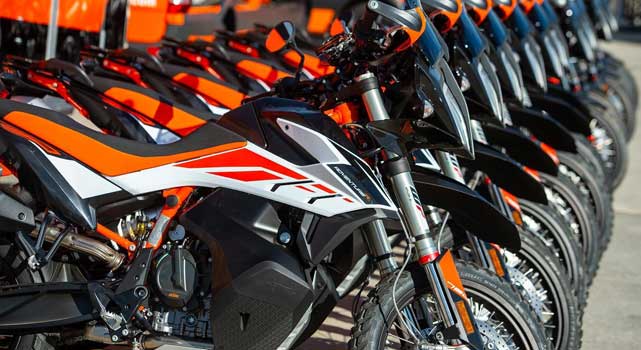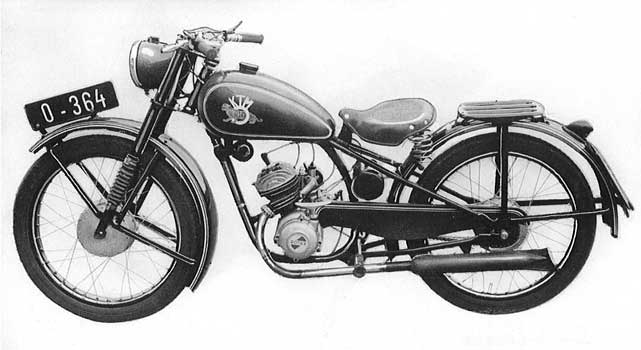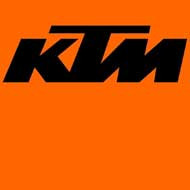The History of KTM Motorcycles
Jul 16th 2019
The History of KTM Motorcycles

A line of 2019 KTM 790 Adventure R motorcycles.
There are three major motorcycle manufacturing epicenters in the world. In America, Wisconsin’s Harley-Davidson is the top producer. In Asia, it’s India’s Hero MotoCorp, which also happens to be the world’s largest motorcycle manufacturer. In Europe, Austria’s KTM AG reigns supreme as Europe’s #1 largest motorcycle brand. In 2016, KTM AG had sold more motorcycles than even such marques as BMW, Aprilia, and Ducati. KTM AG is also the maker of the X-Bow hypercar, which debuted at the Geneva Motor Show in 2008 and is still currently in production today.
Early Days

KTM founder Hans Trunkenpolz, circa 1937.
The story of KTM begins in 1934, long before the idea of high-performance racing bikes and supercars were even conceptualized. Austrian engineer Hans Trunkenpolz opened a car repair shop in Mattighofen. Three years later, Trunkenpolz’s shop was selling DKW motorcycles and the following year, had added Opel automobiles to his company’s offerings. The shop came to be known as Kraftfahrzeug Trunkenpolz Mattighofen: Kraftfahrzeug, the German word for motor vehicle, Trunkenpolz, named after its founder Hans Trunkenpolz; and Mattighofen, the location of the shop. This was the beginning of the KTM brand name.

KTM R100.
During World War II, KTM sustained itself through diesel engine repair jobs and Trunkenpolz’s wife managed the business. The end of World War II saw an almost instantaneous decline in engine repair jobs which led to Trunkenpolz considering the creation and production of his very own motorcycle. Unlike BMW, which was a major supplier to the Third Reich, KTM was not encumbered by the same post-war manufacturing restrictions that were handed down to other former Axis companies by the newly-formed United Nations. Trunkenpolz prototyped his first motorcycle in 1951 called the R100. The R100 used all bespoke in-house parts, except for the Rotax engines sourced by Fitchel & Sachs. Production of the R100 began in 1953 with a team of only 20 employees (including Johann Trunkenpolz, himself). The team was able to produce 3 complete motorcycles per day. That same year, Trunkenpolz partnered with businessman Ernst Kronreif who became a major investor and shareholder of KTM. The company was then renamed Kronreif & Trunkenpolz Mattighofen. The following two years brought forth the introduction of three new products, the R125 Tourist in 1954 and the Grand Tourist and Mirabell scooter in 1955.
An Introduction to Racing and New Models

Egon Dornauer won the 1956 Six Days Trials on a KTM motorcycle.
KTM made their official racing debut in 1954 and secured their first title in the Austrian 125cc national championship of that year. They made an appearance at the 1956 International Six Days Trials, the world’s oldest off-road motorcycle event sanctioned by the FIM, and took home a gold medal with Egon Dornauer riding a KTM motorcycle to victory. KTM built their very first dedicated sport bike in 1957, the Trophy 125cc. The name, no doubt, was in reference to their win at the Austrian 125cc national championship just 3 years earlier. KTM followed through with the debut of their first moped—the Mecky—in 1957, the Ponny I in 1960 and Ponny II in 1962, and the Comet which was new for 1963. The Mecky and Ponny I and II became trusty urban transport while the Comet went on to be a new favorite for off-road racers. KTM won their very first FIM Motocross GP championship in 1974 with Russian motocross racer Guennady Moisseev winning the 250cc class on a KTM 250. This win would be the first of over 260 world championships claimed by KTM throughout the next 40 years.
Company Growth… and Subsequent Fall

1971 KTM Comet 500.
By 1971, KTM had grown their workforce to 400 employees and offered 42 different models in their product lineup. KTM was also producing race-only motorcycles for the motorcycle racing industry. During the 1970s and into the 1980s, KTM started manufacturing radiators for several European automakers. The radiator business alone contributed to a major part of KTM’s income throughout the ‘80s. In 1978, KTM founded their US subsidiary, KTM North America, located in Lorain, Ohio. Back home in Austria, KTM was rebranded as KTM Motor-Fahrzeugbau KG in 1980 and in 1981, the company grew to 700 employees. Income was at $750 million in 1981 and international business accounted for 76% of that money.
While business was good for the former little car shop from Austria, Japanese manufacturers such as Honda, Yamaha, Suzuki, and Kawasaki had entered the international motorcycle market and were spreading like wildfire in the 1980s. It did not take long for the Asian Invasion to topple the former 2-wheel giants and become the new dominant force in motorcycle manufacturing and sales. The almost-overnight success of the Japanese motorcycle brands suffocated KTM’s scooter and moped sales which led to a production hiatus in 1988. With the death of then-CEO Erich Trunkenpolz (son of Hans Trunkenpolz, who had passed in 1962) and a 51% takeover spearheaded by Austrian politician Josef Taus in 1989, the future of KTM was in jeopardy. Taus struggled to turn KTM around back into profitability and by 1991, control of KTM was split across numerous creditor banks.
A New Lease on Life

The 1994 Duke sport bike ushered in a new era of performance at KTM.
The product portfolio which KTM had cultivated during the ‘70s and ‘80s was split into four separate entities in 1992: bicycles were now produced by KTM Fahrrad GmbH, automotive radiators were built by KTM Kühler GmbH, tooling manufacturing was assigned to KTM Werkzeugbau GmbH, and the motorcycle division, the core of KTM’s earliest successes, was now called KTM Sportmotorcycle Gmbh.
KTM Sportmotorcycle GmbH started slow, but was efficiently increasing their production and turnover in the following years. Under new ownership by KTM Motorradholding GmbH (a joint venture between Cross Holding and other investors), KTM Sportmotorcycle gained its footing and was able to absorb the tooling division, KTM Werkzeugbau GmbH. KTM Sportmotorcycle invested more into production and brand new R&D facilities, which led to the output of new innovations and more products. The company, once again, resumed their motorsports interests and acted as both sponsor and competitor in a multitude of officially-sanctioned motorcycle racing events. The Duke sport motorcycle was introduced in 1994, which became the company’s most popular standard model. In 1996, KTM debuted their now signature orange color livery and in 1997, the liquid-cooled four-cylinder Supermoto and Adventure high-performance bikes made their first appearance.
In 1995, KTM purchased Sweden’s Husaberg AB and in 2013, acquired another Swedish competitor, Husqvarna. By 2015, KTM had grown to become Europe’s largest motorcycle manufacturer. Income for that year totaled 1 billion Euro ($1,128,149,000 USD) and KTM was able to incorporate three of the four divisions that were introduced after the split in 1992.
Racing Powerhouse

KTM at the 2019 Dakar Rally.
KTM currently holds 96 MXGP, MX1, and MX2 world championships since 1974 and 114 E1, E2, E3, and Super Enduro world titles beginning in 1990. The company has claimed 260 world championship titles and has 3 consecutive championships in AMA Supercross between 2015 and 2017. KTM made their Dakar Rally debut in 1994 and claimed positions 2nd through 12th in 1998’s event. Between 2001 and 2018, no other manufacturer has had such a stranglehold over the World’s Deadliest Rally Race as KTM. Other cross country rally events undertaken by KTM include the Atlas Rally and the Rallye du Maroc. KTM has 37 world titles in cross country rally races and are 15-time winners of the FIM Cross-Country Rallies World Championship.

A pair of KTM R16s in Red Bull Racing and KTM livery, featuring the famous KTM orange color.
Success has also come to KTM on pavement as well as off-road. In 2003, KTM got involved in road racing; specifically in the 125cc and 250cc classes. KTM won the 2005 Grand Prix constructor’s championship and the Moto3 manufacturer’s title in 2012, followed by manufacturer’s titles in 2014 and 2016, along with the Moto3 class world title in that same year. KTM also fields entries in the MotoGP and Moto2 classes and has been an active competitor in the Superbike International German Championships between 2009 and 2011.

2019 KTM X-Bow race cars.
In 2008, KTM entered the world of hypercars with the X-Bow. The X-Bow is a mid/rear-engine, rear-wheel drive ultra-lightweight sports car designed for street and racetrack use (except in North America, where it can only be purchased as a track-only race car). Carbon fiber construction allows the X-Bow to weigh a shade over 1,700 lbs., a fraction of the curb weight of the everyday passenger car. The current iteration uses an Audi-sourced turbocharged 2.5 litre engine that makes between 295 and 346 horsepower (depending on tune) and sends it to the rear wheels VIA a standard 6-speed manual transmission or a performance 6-speed sequential manual transmission with a racetrack-bred dual-clutch automatic gearbox to be available in the future. Top speed is 150 MPH and 0-60 averages at 3.3 seconds. On the professional racing circuit, the X-Bow won the supersports class of the 2009 British GT Championship, the GT4 class in the 2011 season, and a 2016 GTS championship in the USAC-sanctioned GT World Challenge series.
Range of Performance

KTM is synonymous with 2-wheel racing on dirt and on asphalt.
KTM specializes in high-performance motorcycles for street, off-road, and racetrack use. Their off-road motorcycle lineup is split into four categories: Motocross, Cross-Country, Enduro, and Free Ride. Motocross bikes include the 105, 126, 150, and 250cc SX series (50, 65, and 85 are youth bikes), and the KTM SX-F. The Cross-Country XC bikes includes 150, 250 and 300 cc two-stroke models and 250, 350 and 450 cc four-stroke models. The Endure EXC line is comprised of 250, 350, 450, and 510cc four-stroke motorcycles and the Endure R with a 690 cc engine. The Free Ride series includes the Freeride 250R and the all-electric Freeride E-SX, E-XC, and the street version E-SM which are available for the European market.
KTM’s street bike line traces its lineage back to the original 1994 Duke 620. These bikes are assigned to six categories: Supermoto (690 SMC R, 625 SMC, and 560 SMR), Adventure Tourers (1090 Adventure and 2190 Super Adventure), Sports Tourer (1290 Superduke GT), Naked Bikes (stripped down, standard versions of the Duke and Superduke), Supersport (RC 390 and RC16 race bike), and the recently-discontinued Superbike which consisted of the 1190 RC8 homologated street/racing motorcycle.
Whether you race on dirt or on asphalt, catch air or rip through hairpin turns, Race Driven is the motorcycle and ATV enthusiast's #1 stop for performance and aftermarket parts. Check out our KTM motorcycle category and find the best deals on motorcycle brake pads, brake rotors, motocross chains and sprockets, and other parts for KTM dirt bikes, KTM sport bikes and motorcycles.


